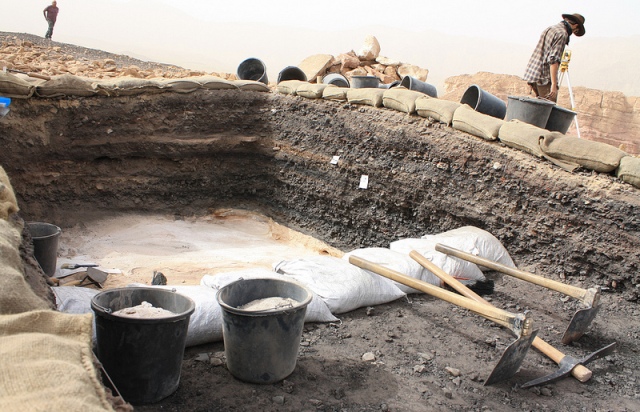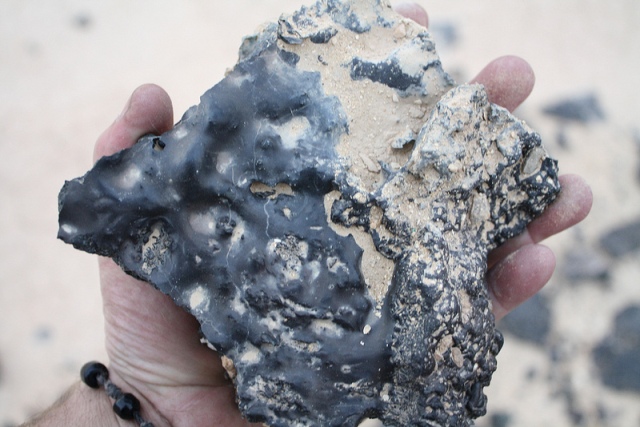By Rivka Borochov
With 10 date pits and one olive pit, researchers at Tel Aviv University have determined that Israel’s Timna Valley copper mines are from the time of the Bible’s King Solomon. History books will need to be revised.
In a dig led by
Dr. Erez Ben-Yosef, archeologists sent organic remains from the ancient copper mine to the world-renowned Oxford Radiocarbon Accelerator Unit at the University of Oxford in England, for carbon dating. The unit dated the pits to the 10th century BCE. This is when, according to the Bible, King Solomon ruled over the land.
 The dig site at the copper mines
The dig site at the copper mines
Previous archeologists at the site in Israel's Arava Desert had dated the mines to the 13th century BCE and assumed they were under Egyptian control at the time.
"The mines are definitely from the period of King Solomon," says Ben-Yosef, a lecturer in the J. M. Alkow Department of Archaeology and ANE Cultures at Tel Aviv University. "They may help us understand the local society, which would have been invisible to us otherwise."
What makes the site particularly tricky to date is that the people who worked there were semi-nomadic tribesmen living in tents; they did not leave behind elaborate buildings or structures. Tents usually disappear over time. Ben-Yosef looked into what the smelters did leave behind: food remains.
Mystery of tent people revealed
So who were the people mining at this immense site?
Researchers like Ben-Yosef wanted clearer answers at Timna, located near the Red Sea coastal town of Eilat. The area is now a national park. Some mining picked up there about 50 years ago, but stopped as the profitability of copper sank.
 Remains of copper
Remains of copper
What Ben-Yosef found may help preserve the otherwise virgin region, tentatively slated for hotel development.
“Big hotels in the middle of the valley? The environmentalists don’t like this at all. While development won’t destroy [the ancient mines], it will destroy wilderness. It is a virgin land full of archeology sites, and actually where they want to build a hotel there are archeological sites,” says Ben-Yosef.
He and his team were able to show that the copper mining at the site reached its peak some three centuries later than thought - during the rule of the great biblical kings.“ We didn’t find anything in particular that can connect the mines to the figure of King Solomon. The big deal is that the mines are dated to the time that he was presumed to be ruling this area,” explains Ben-Yosef.
Shaking off dusty hypotheses
His find lends support to the stories of the Bible. Could King Solomon have been as wealthy as believed? Maybe he collected money and products from the mining operation?
Ben-Yosef can only speculate, but he believes that the mines were operated by the Edomites, a people who lived along the Jordan River and were influenced by the Judean Kingdom to the north. Copper was an important mineral used in the construction of the Jewish Temple in Jerusalem.
Before Ben-Yosef, pioneering Israeli archaeologist Beno Rothenberg drew a connection to Egypt after finding a small Egyptian temple at Timna. Up until then, it was thought that King Solomon had controlled the mines – hence their name. Rothenberg wasn’t a fan of carbon dating, says Ben-Yosef, who scanned through the late researcher’s footnotes. He decided to dig deeper into the truth.
Why now? “It is the first time that anybody cared to send some samples to Oxford – that’s the thing,” he says. “Previously Rothenberg worked there for 40 years but he didn’t believe in carbon dating. It was much less accepted in the ’60s and ’70s as a credible form of dating. But I was suspicious about it. He did send some samples in and found that they were not matching his paradigm, so he just published the results as a footnote, and didn’t consider them important.
“We now have a strong indication that the mines are not Egyptian, but from the days of the Iron Age,” says Ben-Yosef.
Ben-Yosef’s excavation area is known as Slave’s Hill, named by American archaeologist Nelson Glick, who suggested that a hill was built around the mine so the slaves working there couldn’t escape. It was previously untouched and served as a massive smelting camp. The mines were eventually abandoned around the 10th century, says Ben-Yosef, probably due to a military invasion from Egypt, or possibly export competition from high-quality copper being produced in Cyprus.